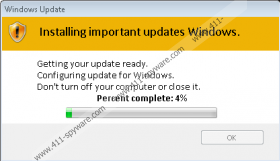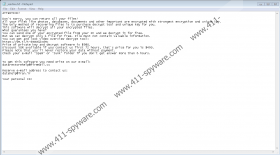Rote Ransomware Removal Guide
Rote Ransomware is a variant of Stop Ransomware that shows a fake update installation window after being launched. As a result, users might not realize that they have opened a malicious file and that their data is being encrypted. After enciphering important files, the malware ought to show a ransom note. Like most of the other threats similar to Stop Ransomware, the malicious application should display a note asking to pay 490 or 980 US dollars to receive decryption tools. It is not a small sum, which is why we recommend considering hackers offer carefully. Also, we advise learning more about the malware before doing anything, and you can find out more about it if you read our full report. Our researchers say that it would be safer to delete Rote Ransomware once it is detected to avoid getting your future data encrypted as well. You can learn how to remove it manually if you check the instruction located below.
Since Rote Ransomware shows a fake updates installation window upon its launch, the malware might be spread via emails or unreliable file-sharing sites. Such sources could say that the malicious installer is a software update or security patch. To avoid being tricked into launching such data, you should never open files received from unknown senders or untrustworthy websites. If you have even the smallest doubt, we recommend scanning files in question with a reliable antimalware tool. Also, it is essential to understand that updates and patches are not files that should be delivered to users via email or file-sharing sites. Such content should be received from legitimate websites only. Usually, there is no need to download or install such content manually. Your operating system or your antimalware tool should notify you about necessary updates/patches and ask for your permission to apply them or do so automatically.
As soon as Rote Ransomware encrypts targeted files, which could be pictures and other personal data, it should close the fake update installation window. Soon a victim might notice that his files are marked with the .rote extension, for example, document.docx.rote. Also, victims should find a document called _readme.txt on their Desktop and possibly in other locations containing encrypted files. After opening this file, you should see a text saying: “ATTENTION! Don't worry, you can return all your files!” Also, the message ought to explain why the files can no longer be opened and that they can be restored with special decryption tools. Of course, in exchange for providing such tools, the hackers wish to get a particular sum of Bitcoins. To scare users, Rote Ransomware’s developers suggest paying in 72 hours, or else they will ask for a full price, which is 980 US dollars. No doubt, it is a considerable amount of money, especially when there are no guarantees you would get what you might pay for. Thus, we advise against it if you fear to lose your money in vain.
Another thing users ought to know about Rote Ransomware is that it might be able to restart with the operating system. Consequently, it is possible it could encrypt new files upon every system restart. To make sure it does not happen, we believe it would be best to remove Rote Ransomware. One of the ways to eliminate the malicious application is to restart it in Safe Mode and erase its files manually. You can find the list of data the malware creates and explanations on how to delete it in the instructions located below this paragraph. The other way to remove Rote Ransomware is to scan your system with a reliable antimalware tool and press it displayed deletion button.
Restart the device in Safe Mode with Networking
Windows 8 and Windows 10
- Click Win+I or navigate to the Start menu and click the Power button.
- Press and hold Shift and click Restart.
- Choose Troubleshoot and choose Advanced Options.
- Pick Startup Settings and press Restart.
- Press the F5 key and reboot the system.
Windows XP/Windows Vista/Windows 7
- Open Start, press Shutdown options and tap Restart.
- Press and hold the F8 key when your computer is restarting.
- Wait till you see the Advanced Boot Options window.
- Pick Safe Mode with Networking.
- Press Enter and log on to your computer.
Get rid of Rote Ransomware
- Tap Win+E.
- Locate the following directories:
%TEMP%
%USERPROFILE%\Desktop
%USERPROFILE%\Downloads - Find a malicious file downloaded before the malware appeared (e.g., updatewin.exe).
- Right-click the doubtful file and select Delete.
- Go to this location: %WINDIR%\System32\Tasks
- Find a task called Time Trigger Task.
- Right-click Time Trigger Task and select Delete.
- Search for these locations:
%LOCALAPPDATA%
%USERPROFILE%\Local Settings\Application Data - Find folders with random names, e.g., 98476567-cf82-2ac9-c730-d7b68b0c107a; they ought to contain malicious .exe files, e.g., updatewin.exe.
- Right-click malicious folders with random names and select Delete.
- Go to these locations:
%LOCALAPPDATA%
%USERPROFILE%\Local Settings\Application Data - Find files named script.ps1.
- Right-click them and press Delete.
- Leave File Explorer.
- Tap Win+R.
- Insert Regedit and click OK.
- Go to this path: HKCU\Software\Microsoft\Windows\CurrentVersion\Run
- Locate a value name called SysHelper.
- Right-click it and press Delete.
- Leave Registry Editor.
- Empty Recycle bin.
- Reboot the device.
Rote Ransomware Screenshots:



